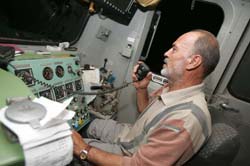Our Services
- CBTC
- ETCS
- FRMCS
- Telemetry
- Security Technology
- Payment Architecture Governance
- Parking System Integration
- Research
- Resource Capability


GSM-R (Digital Railway Communications)
GSM-R Brief Technology Overview
Global System for Mobile Communications - Railway (GSM-R) is an international, digital mobile communication system specifically developed for railway communication and applications. GSM-R is founded on GSM technology and consequently benefits from the economy of scale of the extensive range of pre-existing GSM technology.
First developed in Europe, its goal is to achieve interoperability using a single communication platform. It is used for communication between train and control centres. It facilitates Advanced Speech Call Items (ASCI) and provides signalling information direct to the train driver.
This tightly integrated solution realises the three additional service enablers:
- eMLPP (Multi-Level Precedence and Pre-emption Service)
- VBS (Voice Broadcast Service)
- VGCS (Voice Group Call Service)
These ASCI services of eMLPP, VGCS and VBS facilitate railway operator specific functionality, including function addressing, function numbering representation, access matrix and addressing based on LDA and eLDA location.
A framework of functionality deemed common across railway operators is described by the European Integrated Radio Enhanced Network (EIRENE) memorandum of understanding architecture frameworks developed by the International Union of Railways (UIC).
Exploiting this platform approach empowers railway operators to realise bespoke applications tailored specifically to their operational needs without compromising the established pedigree of commercial subsystem GSM/EIRENE offerings.
The operation model of GSM-R system can be generalised as follows:
GSM-R Operation = GSM + ASCI + EIRENE + Individual Railway Operator Applications
